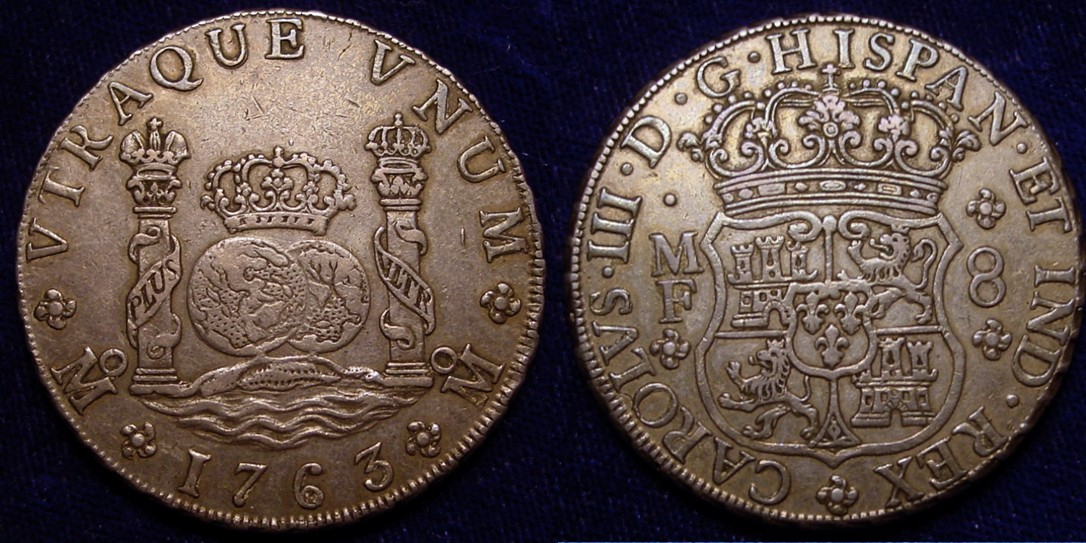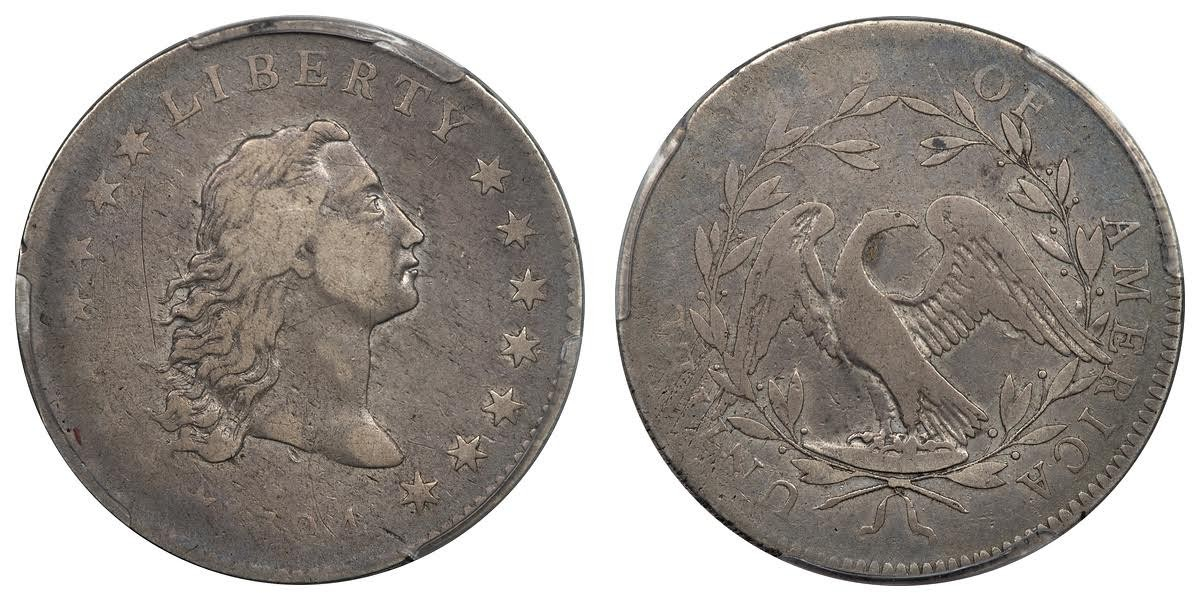Howdy, Stranger!
It looks like you're new here. If you want to get involved, click one of these buttons!
Quick Links
A Guide to Collecting the Early U.S. Silver Dollars by Date and Major Design Type, Part 1
The Early U.S. silver dollars have long been collector favorites. These large, impressive coins were one of the two flagship products (the $10 gold piece or “eagle” was the second) for the first United States Mint. They were exported to Europe, Asia and the Caribbean in the late 1790s and early 1800s. The export of those dollars prompted President Thomas Jefferson to suspend the coinage of the silver dollar in 1804 which brought a premature end to the series.

A 1761 Spanish Milled Dollar. This coin is still "raw." My grade is AU-53.
The early U.S. dollars were inspired by the Spanish Milled Dollar or pieces of eight. Those Spanish colonial coins, which were minted in Mexico and South America, were a world currency. Many of those coins were a principal form of money in the American colonies prior to the Revolutionary War. They would continue to be one of the mainstays for domestic and world commerce after the United States won its independence. It was therefore not surprising that the first U.S. dollars were about the same size as the Spanish coin. The Spanish dollar would have legal tender status in the U.S. until 1857, almost until the outbreak of the American Civil War.
Like all of the early American Mint coinage, the silver dollar was authorized by the Coinage Act of 1792. That law specified that the dollar contained 371.25 grains of pure silver. This number was based upon a survey that treasury secretary, Alexander Hamilton, conducted of Spanish silver coins that were circulating in the United States in 1791. Hamilton set the total weight of the dollar at 416 grains.
The Coinage Act of 1792 required chief coiner, Henry Voigt, and assayer, Albion Cox, post bonds of $10,000 each. That was a huge sum at the time, and neither man was able to raise it, which delayed the coinage a silver and gold coins. The mint only issued copper coinage in 1793 and much of 1794. Ultimately Thomas Jefferson convinced Congress to lower the bonds and made arrangements for those two key mint officials to receive the necessary financial backing from wealthy individuals. Finally, the mint was able to issue the first American silver dollars in October 1794.
The First Mint Scandal
Hamilton recommended and Congress agreed to set the composition alloy for the silver coinage at .8924 silver and .1076 copper. In the spring of 1794, before the mint had issued any silver coins, Chief Assayer, Albian Cox, asked Mint Director, David Rittenhouse, to allow him to increase the silver fineness to .900. This change would Cox’s job easier since the standard would be a round number. Cox absurdly argued that the silver coins produced with the slightly lower fineness would quickly turn black while in circulation. Surprisingly Rittenhouse bought into this point and agreed to this illegal change in the standards. It would result the mint’s first major scandal.
Since the weight of the silver coins was reduced to reflect the higher percentage of silver, the resulting coins contained more silver than the law required. Therefore, those who deposited silver at the mint for coinage were routinely short changed with fewer coins that they should have received. My calculations indicate that depositors were shorted one dollar for every 118 dollars they received, in round numbers.
This illegal practice continued while David Rittenhouse and his temporary replacement, William de Saussure, were the Directors of the Mint. Neither Edmond Randolph, who had replaced Thomas Jefferson as secretary of state,[1] nor President George Washington knew about the illegal mint policy. When Elias Boudinot took over as Mint Director on October 28, 1795, he was informed about the illegal .900 silver coin standard. He ordered an immediate halt to the practice and re-instated the legal standard.
When those who had deposited silver for coinage during this period learned about the scandal, they demanded redress. Chief among them was Philadelphia Merchant, John Vaughn, who claimed that he had been shorted $2,300, which was a considerable sum at the time.
The Treasury Department dragged its feet on compensating the depositors. Mint Director Boudinot made the argument that Vaughn had received all of his silver, which was true, but the director ignored that fact that Vaughn had gotten back fewer dollars than he was entitled to receive. Finally, Congress voted to compensate Vaughn in 1800. The Congress did not get around to changing the standard to the more reasonable .900 silver, .100 copper alloy until 1837.

Although it has VF sharpness, this 1794 Dollar displays the strike weakness that plagued these first dollars. Photo courtesy Harry Laibstain.
The 1794 Silver Dollar
The 1794 silver dollar is one of the premier classic coins in the United States series. It was the first dollar struck at the Philadelphia Mint after it officially opened for business in February 1793. A great many collectors have had a strong interest in this piece for more than 150 years. According to Q. David Bowers[1], the value of a 1794 dollar in 1860 ranged from $13 in VG to $200 in Mint State. Those values have increased over the insuring decades. A piece graded SP-66 (Specimen or special strike) holds the record price paid for a single silver coin of $10,016,875.00. Each of the other certified Mint State examples have sold for more than a million dollars in recent years.
The obverse design features a bust of Ms. Liberty with her hair swept back from her face. The design is similar to the Pole to Cap design that appears on the early half cents and large cents without the liberty cap. The date is below the bust of Ms. Liberty and the word “LIBERTY” appears above her head. At the sides are 15 stars which corresponded with the number of states that were in the union at the time. Eight stars are on left and seven are on the right.
The reverse features a skinny eagle surrounded by a wreath. I have compared the appearance of this eagle with a pterodactyl or winged dinosaur. The legend, “UNITED STATES OF AMERICA,” appears around the wreath.
There is no indication of the face value of the coin on the obverse or reverse. The only mark of value is around the edge. It reads, “hundred cents one dollar or unit.” All of the early dollars are valued in this way. The world “DOLLAR” would not appear on the face of the dollar coin until the series was resumed in 1836.
The reported mintage for the 1794 dollar was 1,758 pieces which were delivered in October of that year. Today there are an estimated 150 survivors. That makes the 1794 dollar a very scarce coin, R-4, according to the Sheldon rarity scale (estimated 76 to 200 pieces known), but not a rare piece. Collectors who have the funds, and who are willing to pay the price, can be assured of having opportunities to purchase a 1794 dollar.
Many of the survivors are impaired, and a large number of pieces without problems are poorly struck. The largest coin press that was available at the first mint in the fall of 1794 and early 1795 was built to strike coins no larger than a half dollar. Almost all 1794 dollars show strike weaknesses on the left side of the obverse. Some coins are weakly stuck in other areas on both sides of the piece. Naturally these coins lost more sharpness as they were worn down in circulation.
Since 2015, auction prices for 1794 dollars have ranged from $129,250 in Fine, $146,875 in VF, $270,250 in EF, $910,625 in Ch AU and $2,820,000 in MS-64. Obviously the 1794 dollar is beyond the means of most collectors. As such most of us must be content to leave that spot in our date sets open.


Comments